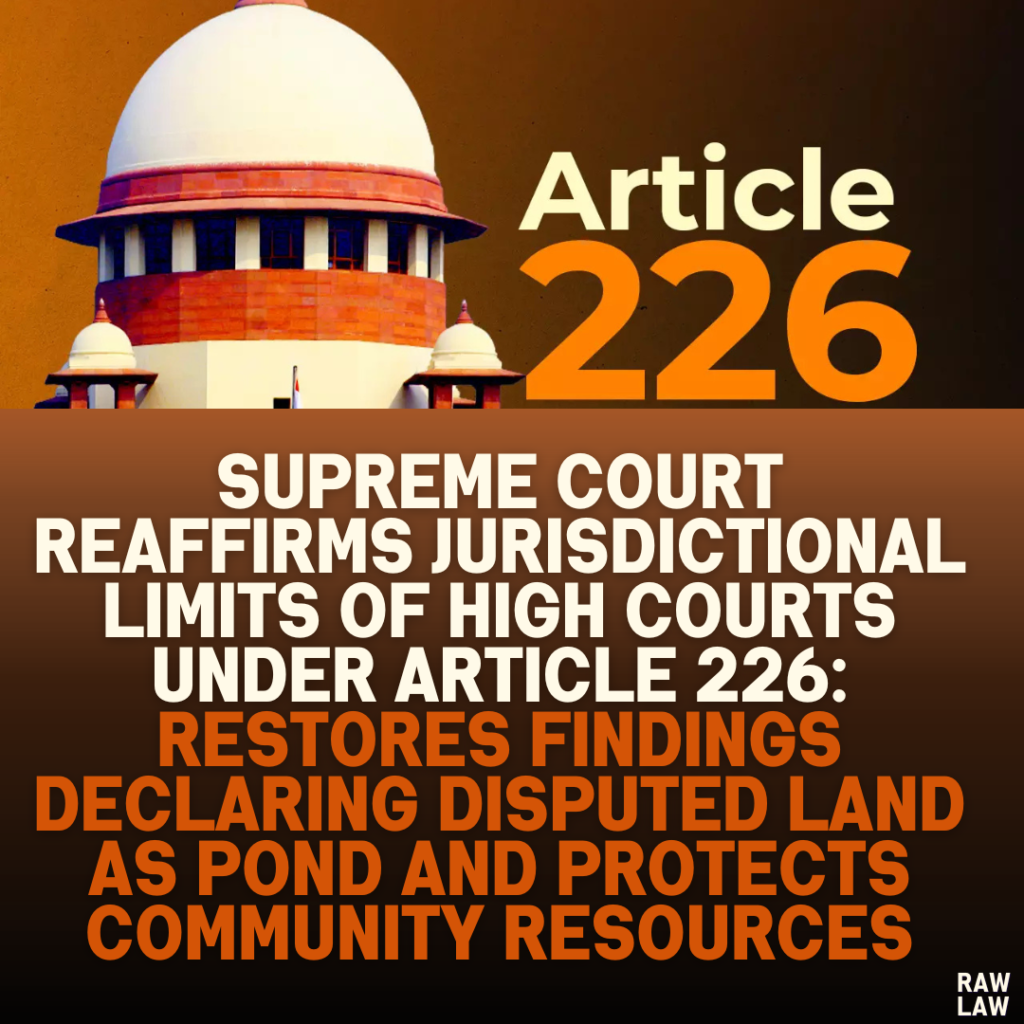Court’s Decision:
The Supreme Court allowed the appeals filed by the appellant and set aside the judgments of the High Court of Judicature at Allahabad. It restored the findings of the lower authorities, declaring the disputed land as a pond (“Johad”). The Supreme Court held that the High Court had exceeded its jurisdiction under Article 226 of the Constitution by reappreciating the evidence and substituting its own findings for those of the authorities below without demonstrating any perversity or illegality.
Facts:
- The dispute concerned a piece of land (Khasra No. 103), recorded in 1970 as “Johad (Pond)” in the revenue records.
- In 2003, the respondent claimed ownership of the land, asserting rights based on a patta allegedly issued in 1981-82.
- The appellant opposed this claim, arguing that the land was a pond used by villagers for water needs and was excluded from the consolidation scheme as a water reservoir.
- Lower authorities, including the Additional District Magistrate and the Additional Commissioner, found that the respondent’s patta was fictitious and unsupported by evidence.
- The High Court, in writ jurisdiction, set aside the findings of the authorities and declared the land as “Oosar (barren land)” instead of a pond.
Issues:
- Did the High Court act within its jurisdiction under Article 226 by reappreciating the evidence and overturning the lower authorities’ findings?
- Was the High Court justified in declaring the land “Oosar” despite the concurrent findings of the lower authorities that it was a pond?
Petitioner’s Arguments:
- The findings of the Additional District Magistrate and Additional Commissioner were based on reliable evidence, including revenue records and the absence of proof for the patta.
- The High Court exceeded its jurisdiction by acting as an appellate court, reweighing evidence, and substituting its own findings.
- The respondent’s claim relied on fictitious records, as no allotment file or valid patta existed.
Respondent’s Arguments:
- The land was recorded as “Oosar” in earlier revenue records, and its subsequent classification as “Johad” was due to administrative confusion.
- The respondent should not be penalized for missing allotment files, which were beyond their control.
- The High Court acted correctly in reexamining the matter and rectifying the error in the land’s classification.
Analysis of the Law:
- Scope of Article 226 Jurisdiction:
- Article 226 empowers High Courts to issue writs for correcting jurisdictional errors or addressing acts of illegality.
- However, it does not allow High Courts to act as appellate courts to reappreciate evidence or substitute their findings unless the lower authorities’ findings are patently perverse or lack evidentiary basis.
- Relevant Precedents:
- Chandavarkar Sita Ratna Rao v. Ashalata S. Guram: High Courts cannot interfere with findings of fact unless there is no evidence to support such findings or the findings are perverse.
- Shamshad Ahmad v. Tilak Raj Bajaj: High Courts’ supervisory jurisdiction is limited and cannot be used to review or reweigh evidence.
- Krishnanand v. Director of Consolidation: High Courts cannot disturb factual findings unless the authorities acted beyond their jurisdiction or rendered perverse findings.
Precedent Analysis:
The Court applied the above precedents to conclude that:
- The High Court improperly substituted its factual findings for those of the authorities below.
- The High Court’s actions undermined the established principles of judicial restraint under Article 226.
Court’s Reasoning:
- The lower authorities’ findings were based on credible evidence:
- The revenue records consistently recorded the land as a pond.
- The respondent failed to prove the existence of a valid patta or allotment file.
- The alleged patta had discrepancies, including contradictory dates of signing.
- The High Court ignored this evidence and reclassified the land as “Oosar” without a valid basis.
- The High Court’s interference disrupted the villagers’ right to use the land as a water reservoir, protected under a permanent injunction issued by the Civil Judge.
- The High Court’s supervisory jurisdiction does not extend to reappreciating evidence or overturning factual findings without demonstrating jurisdictional excess or perversity.
Conclusion:
- The Supreme Court restored the lower authorities’ findings that the land was a pond.
- It declared the High Court’s judgment as an overreach of its writ jurisdiction.
- The permanent injunction granted by the Civil Judge, protecting the villagers’ right to the pond, was upheld.
Implications:
- This judgment reaffirms the limits of High Courts’ writ jurisdiction under Article 226.
- It underscores the importance of respecting concurrent findings of fact by lower authorities unless there is a clear error of law or perversity.
- It protects community resources like ponds, ensuring they are not arbitrarily reclassified or misused.



